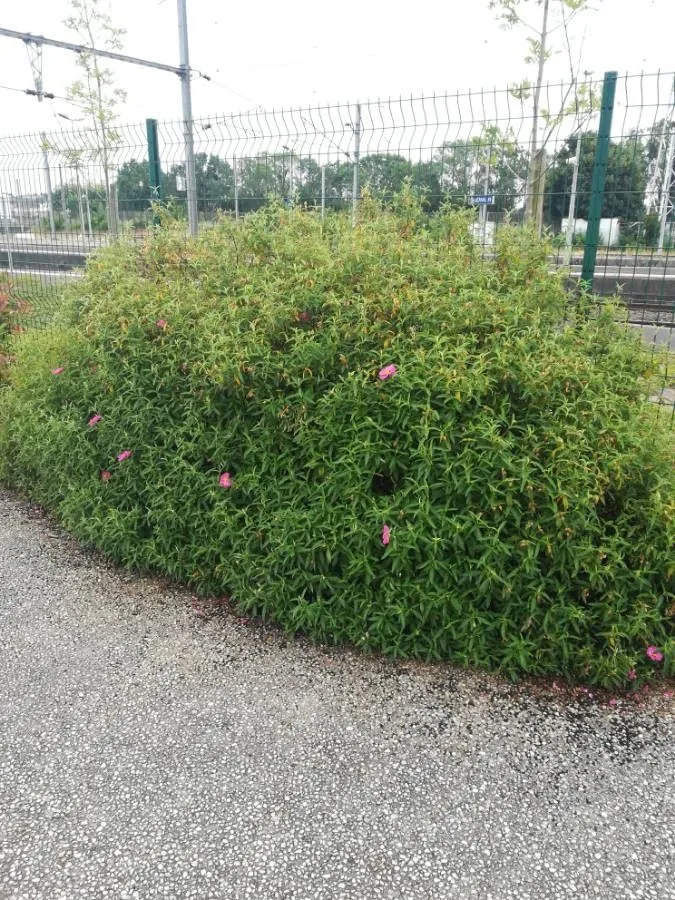
Author: L.
Bibliography: Sp. Pl. ed. 2: 738 (1762)
Year: 1762
Status: accepted
Rank: species
Genus: Cistus
Vegetable: False
Observations: C. & E. Medit.
The Pink Rockrose, scientifically known as Cistus creticus, is a charming and resilient flowering shrub that adds a splash of vibrant color to Mediterranean landscapes. This species was first described in 1762 and owes its classification to the renowned botanist Carl Linnaeus.
Belonging to the Cistaceae family, the Pink Rockrose thrives in the rocky terrains and sunny slopes of Central and Eastern Mediterranean regions. Its hardy nature and adaptability make it a favored choice for gardens seeking low-maintenance yet aesthetically pleasing plants.
One of the most striking features of Cistus creticus is its delicate, papery blooms, which typically range in shades of pink, creating a delightful contrast against its dark green, slightly wrinkled leaves. The flowers, while appearing fragile, are remarkably resilient to the harsh Mediterranean sun, opening in the morning and often closing by late afternoon.
In addition to its beauty, the Pink Rockrose plays an essential role in its native ecosystem. It’s known for its ability to thrive in poor, well-drained soils where few other plants can survive. This adaptability not only helps prevent soil erosion but also provides habitat and food for various pollinators, particularly bees.
Gardeners and horticulturists value the Pink Rockrose not only for its ornamental appeal but also for its drought-resistant properties. Once established, the plant requires minimal water, making it an excellent choice for xeriscaping and sustainable garden practices.
Overall, Cistus creticus is a testament to nature’s ability to flourish in challenging environments, bringing beauty and resilience together in a perfect blend. Whether you’re looking to add a splash of color to your garden or contribute to eco-friendly landscaping, the Pink Rockrose stands out as a remarkable and practical choice.
Dan: stenrose
Swe: kretacistros
Fra: ciste de crète
Eng: pink rockrose, cretan rockrose
En: Pink rockrose, Cretan rockrose, Grey Cistus
Ar: قريضة كريتية
Br: Roz-roc’h-Kreta
Ca: Estepa de Creta, Estepa menorquina
Co: Muchju rossu
Hr: Ružičasti bušin
Da: Stenrose
Fi: Kreetankistus
Fr: Ciste de Crète
De: Kretische Zistrose, Klebriges Ciströschen, Kretische Cistrose
He: לוטם שעיר
It: Cisto di Creta, Cisto rosso
Ml: സിസ്റ്റസ് ക്രെറ്റിക്കസ്
Pl: Czystek kreteński
Sv: Kretacistros, Klippros
Tr: Tüylü laden
Taken Feb 13, 2020 by Hosseini Amjad (cc-by-sa)
Taken Jun 5, 2022 by Elie Eid (cc-by-sa)
Taken Jun 5, 2022 by Elie Eid (cc-by-sa)
Taken Jan 2, 2020 by Yves Crettaz (cc-by-sa)
Taken Jun 5, 2022 by Elie Eid (cc-by-sa)
Taken Feb 1, 2020 by Michèle FAYOT (cc-by-sa)
Taken Nov 26, 2021 by Jordan Lefort (cc-by-sa)
Taken May 24, 2022 by Lison Vu (cc-by-sa)
Taken Dec 31, 2021 by Bea (cc-by-sa)
Taken Jun 5, 2015 by enzo (cc-by-sa)
Taken Jul 24, 2018 by Renaud Brochiero (cc-by-sa)
Taken Aug 6, 2021 by Marie-Pierre GIROUX (cc-by-sa)
Taken Oct 8, 2005 by Tela Botanica − Errol VELA (cc-by-sa)
Taken Dec 31, 2021 by Bea (cc-by-sa)
Taken Dec 31, 2021 by Bea (cc-by-sa)
Taken Jun 21, 2018 by philippe nicolas (cc-by-sa)
Taken Oct 30, 2009 by Tela Botanica − Yoan MARTIN (cc-by-sa)
Taken Mar 11, 2021 by Tolga COSKUN (cc-by-sa)
Taken Apr 26, 2021 by Jean-Louis ESPURT (cc-by-sa)
Taken Apr 27, 2022 by Raffaello 2 Garofalo (cc-by-sa)
Taken Apr 27, 2020 by mery (cc-by-sa)
Taken Jan 28, 2017 by Yoan MARTIN (cc-by-sa)
Taken Apr 17, 2014 by Tela Botanica − Henri SCORDIA (cc-by-sa)
Taken Apr 12, 2001 by Tela Botanica − Liliane ROUBAUDI (cc-by-sa)
Taken Apr 12, 2001 by Tela Botanica − Liliane ROUBAUDI (cc-by-sa)
© copyright of the Board of Trustees of the Royal Botanic Gardens, Kew.
© copyright of the Board of Trustees of the Royal Botanic Gardens, Kew.
© copyright of the Board of Trustees of the Royal Botanic Gardens, Kew.
Taken May 20, 2021 by Alessandro Tonucci (cc-by-sa)
Taken Feb 21, 2021 by t g (cc-by-sa)
Taken Mar 9, 2021 by Monteiro Henrique (cc-by-sa)
Taken Nov 22, 2020 by Silva Rivas Beatriz Silva Rivas (cc-by-sa)
Taken Apr 27, 2022 by Raffaello 2 Garofalo (cc-by-sa)
Growth habit: Subshrub
Ph maximum: 5.0
Ph minimum: 4.5
Light: 8
Atmospheric humidity: 5
Soil nutriments: 4
Family: Myrtaceae Author: (F.Muell.) K.D.Hill & L.A.S.Johnson Bibliography: Telopea 6: 402 (1995) Year: 1995 Status:…
Family: Rubiaceae Author: Pierre ex A.Froehner Bibliography: Notizbl. Bot. Gart. Berlin-Dahlem 1: 237 (1897) Year:…
Family: Sapindaceae Author: Koidz. Bibliography: J. Coll. Sci. Imp. Univ. Tokyo 32(1): 38 (1911) Year:…
Family: Asteraceae Author: A.Gray Bibliography: Pacif. Railr. Rep.: 107 (1857) Year: 1857 Status: accepted Rank:…
Family: Fabaceae Author: Medik. Bibliography: Vorles. Churpfälz. Phys.-Ökon. Ges. 2: 398 (1787) Year: 1787 Status:…
Family: Aspleniaceae Author: (Cav.) Alston Bibliography: Bull. Misc. Inform. Kew 1932: 309 (1932) Year: 1932…